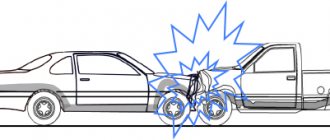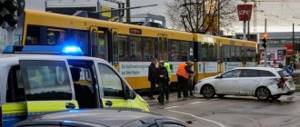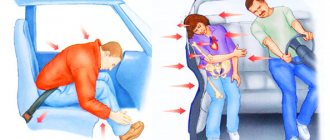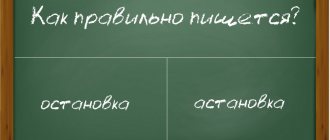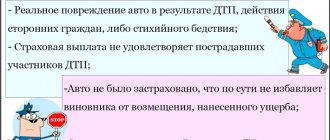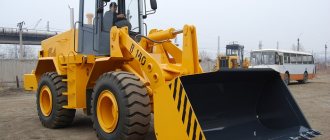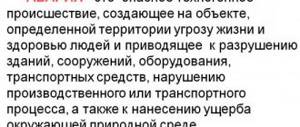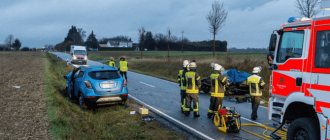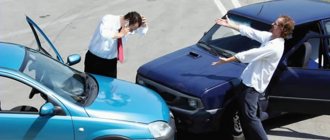Road accident. Definition of the concept
Road traffic accident is an event that occurred during the movement of a vehicle on the road and with its participation, in which people were killed or injured, vehicles, structures, cargo were damaged, or other material damage was caused (Article 2 of the Federal Law of December 10, 1995 N 196 - Federal Law “On Road Safety”)
The identical definition of the concept of “road accident” is contained in clause 1.2 of the Road Traffic Rules of the Russian Federation, approved by Resolution of the Council of Ministers - Government of the Russian Federation of October 23, 1993 N 1090.
Road traffic accident; (RTA): An event that occurred during the movement of a vehicle on the road and with its participation, in which people were killed or injured, vehicles, structures, cargo were damaged, or other material damage was caused (clause 3.1.2 of the Recommendations for the recording and analysis of road accidents). -transport accidents on highways of the Russian Federation, approved by the order of Rosavtodor dated May 12, 2015 N 853-r).
A road traffic accident (RTA) is an event that occurred during the movement of a vehicle on the road and with its participation, in which people were killed or injured, vehicles, cargo, structures were damaged (lost since May 12, 2015 Rules for accounting and analysis of road traffic -transport accidents on highways of the Russian Federation, approved by the Federal Road Service of Russia on May 29, 1998).
○ Criminal liability.
In the event of the death of a victim in an accident, as well as the infliction of serious harm to his health, criminal liability is applied to the culprit in accordance with the relevant provisions of the Criminal Code of the Russian Federation.
The degree of responsibility is determined by the court taking into account all the circumstances of the case (aggravating or mitigating) proven during the trial.
- According to Part 1 of Article 264 of the Criminal Code of the Russian Federation, the culprit of an accident for unintentionally causing grievous bodily harm faces from 6 to 36 months of imprisonment or correctional labor for up to 2 years. An additional measure of deprivation of rights for up to 3 years is also applied.
If the result of an accident is the death of the victim, the punishment for the culprit is increased:
- If one person died, the term of correctional labor increases to 4 years, and imprisonment - to 5. If the culprit was drunk, the penalty is imprisonment for 7 years.
- If the number of deaths is more than one, the term of correctional labor increases to 5 years, imprisonment - to 7 years. If there are signs of intoxication, each penalty is increased by another 2 years.
If the result of an accident is regulated by the Criminal Code of the Russian Federation, the investigation is conducted by the investigative authorities, after which the case is considered in court. It should be noted that in addition to the penalty applied, the culprit must also compensate for material damage to the injured party.
Road accident registration by Rosstat
Rosstat Order No. 887 dated December 29, 2017 “On approval of methodological provisions for transport statistics” (this order was not officially published) contains the following provisions:
- Deceased - a person who died at the scene of a traffic accident or died within 30 days after the accident.
- Wounded - a person who received bodily injuries at the scene of a road traffic accident, which led to his hospitalization for a period of at least one day, or the need for outpatient treatment.
State statistical reporting on road traffic accidents includes information only on road traffic accidents in which people were killed or injured.
Road traffic accidents are taken into account according to the following main criteria:
- types (collision, rollover, collision with a standing vehicle, pedestrian, obstacle, cyclist, passenger fall);
- places of commission (in populated areas, on public roads, private roads, toll roads, non-public roads, at railway crossings and other places);
- reasons, the main of which are: violation of traffic rules (including by vehicle drivers), technical malfunction of vehicles and unsatisfactory conditions of maintenance and arrangement of the road network;
- categories of victims (drivers, cyclists, passengers, pedestrians);
- participants in incidents (including those involving pedestrians and children under 16 years of age);
- time of occurrence (days of the week, time of day).
Types of road traffic accidents (RTA) in ODM 218.6.015-2015
In the Industry road methodological document ODM 218.6.015-2015, valid since May 12, 2015, “Recommendations for recording and analysis of road accidents on highways of the Russian Federation,” approved. By order of Rosavtodor dated May 12, 2015 N 853-r, only the following types of accidents are identified:
road traffic accident with victims: An event that occurred during the movement of a vehicle on the road and with its participation, in which at least one person was killed or injured (clause 3.1.3). In this case, a person injured in an accident is understood to be a person who received bodily injuries in an accident that resulted in his hospitalization for a period of at least one day or the need for outpatient treatment (clause 3.1.10). A person who died in an accident is defined as a person who died at the scene of an accident or died from its consequences within the next 30 days.
road traffic accident with particularly grave consequences: A road traffic accident in which 5 or more people died, 10 people or more were injured. (clause 3.1.4).
The previous Rules for accounting and analysis of road accidents on highways of the Russian Federation, approved by the Federal Road Service of Russia on May 29, 1998, contained a more detailed description of a road accident, which differed more favorably from the current Recommendations approved by Rosavtodor on May 12, 2015.
○ Administrative responsibility.
This type of liability applies if harm to the health of the injured party is mild or moderate. The degree of punishment is determined on the basis of the relevant paragraphs of the Code of Administrative Offenses of the Russian Federation, based on the specific situation.
- In case of mild harm to health, the culprit is given a fine in the amount of 2000 to 5000 rubles or deprivation of rights from 1 to 1.5 years (paragraph 2, clause 1, article 12.24 of the Code of Administrative Offenses of the Russian Federation).
- If the harm to health is determined to be average, a fine of 10,000 to 25,000 rubles or deprivation of rights for a period of 1.5 to 2 years may be imposed (paragraph 2, paragraph 2, article 12.24 of the Code of Administrative Offenses of the Russian Federation).
What exact fine will be assigned for an accident depends on the specific features of the case.
Most often, accidents occur due to violation of the following rules:
- Prohibition on the use of telephones while driving a vehicle (Article 12.36.1 of the Code of Administrative Offenses of the Russian Federation).
- Turning on the turn signal when changing the trajectory of movement (Article 12.14 of the Code of Administrative Offenses of the Russian Federation).
- Maintaining distance on the road (Part 1 of Article 12.15 of the Code of Administrative Offenses of the Russian Federation).
- According to Article 4.6 of the Code of Administrative Offenses of the Russian Federation, a person who has been imposed an administrative penalty for committing an administrative offense is considered subject to this punishment within one year from the date of completion of the execution of the decision on the imposition of an administrative penalty.
- Repeated commission of a homogeneous administrative offense, if for committing the first administrative offense the person has already been subjected to an administrative penalty for which the period provided for in Article 4.6 of the Code of Administrative Offenses has not expired, is recognized as a circumstance aggravating administrative liability. (Article 4.3. Code of Administrative Offenses of the Russian Federation)
Administrative liability for the culprit of an accident can be applied in the form of:
- Warnings - executed by the judge, body, official who made the decision, by delivering or sending a copy of the decision.
- Imposition of an administrative fine - executed by the official who made the decision by delivering a protocol.
- Revocation of driver's license by court order.
Bringing to administrative liability is carried out by drawing up a protocol on the offense, drawn up in the presence of the offender.
Types of road traffic accidents (RTA) in the repealed 1998 Rules
In the Rules for recording and analysis of traffic accidents on highways of the Russian Federation, in force until May 12, 2015, approved. By Order of the Federal Road Service of Russia dated May 29, 1998 N 168, road traffic accidents were divided into the following types:
Collision is an incident in which moving vehicles collide with each other or with railway rolling stock.
This type also includes collisions with a suddenly stopped vehicle (in front of a traffic light, during a traffic jam or due to a technical malfunction) and collisions of railway rolling stock with a vehicle stopped (left) on the tracks.
Rollover is an incident in which a moving vehicle overturned (for example, the court came to the conclusion that the overturning of a truck crane on the territory of a joint stock company cannot be regarded as a traffic accident, since it did not occur while the vehicle was moving along the road, as provided for clause 1.1 of the Traffic Rules; resolution of the Federal Antimonopoly Service of the West Siberian District dated October 28, 2008 N F04-6437/2008 (14507-A70-11) in case N A70-470/11-2008).
Collision with a stationary vehicle is an incident in which a moving vehicle collides with a stationary vehicle or a trailer or semi-trailer.
Hitting an obstacle is an incident in which a vehicle runs over or hits a stationary object (bridge support, pole, tree, fence, etc.).
A pedestrian collision is an incident in which a vehicle hits a person or the person collides with a moving vehicle.
This type also includes incidents in which pedestrians were injured by a load or object transported by a vehicle (boards, containers, cable, etc.).
A collision with a cyclist is an incident in which a vehicle hits a cyclist or the cyclist collides with a moving vehicle.
A horse-drawn vehicle collision is an incident in which a vehicle hits draft animals, as well as the carts transported by these animals, or the draft animals or carts transported by these animals hit a moving vehicle. This type also includes hitting an animal.
Passenger fall is an incident in which a passenger falls from a moving vehicle or in the cabin (body) of a moving vehicle as a result of a sudden change in speed or trajectory, etc., if it cannot be attributed to another type of accident.
A passenger falling from a stationary vehicle while boarding (disembarking) at a bus stop is not an accident.
Another type of accident is an incident not related to the types indicated above. This includes the fall of a transported load or an object thrown by a wheel onto a person, animal or other vehicle, a collision with persons who are not road users, a collision with a suddenly appeared obstacle (a fallen load, a separated wheel, etc.), etc.
Classification by causes of accidents
All accidents can be classified into:
- common to all types of accidents;
- specific for a certain type of accident.
The reasons common to all types of accidents are:
- being in an inadequate state (under the influence of psychoactive substances, tranquilizers, sick, tired);
- over speed;
- diverting the attention of the person driving the vehicle to foreign objects: cell phone, tablet, etc.
Specific causes are the reasons that in most cases lead to road accidents of a certain mechanism of occurrence.
For example, failure to allow a vehicle with the right of way to pass often leads to lateral or tangential collisions, technical malfunction of the brakes leads to rear collisions, driving into the oncoming lane leads to frontal collisions, etc.
Some types of reasons, for example, being intoxicated, make a person guilty a priori , without further consideration of the circumstances of the accident.
Another type of accident is a non-contact accident.
The last paragraph of paragraph 3 of Appendix 3 to the specified rules for recording and analyzing traffic accidents on highways..., apparently, also included “another type of accident.” We are talking, in particular, about so-called non-contact accidents.
In a non-contact accident due to the fault of the driver of the vehicle (who violated the traffic rules), harm is caused to third parties, while there is no physical contact between the vehicle of the harm-doer and the vehicle of the injured person (as well as any other object to which the harm was caused). For more information on the topic of non-contact road accidents, see the article “Non-contact road accidents. Arbitrage practice"
Falling objects on a car, snow from roofs - an accident?
To classify an event as an accident, it matters whether the “injured” car was moving at the time the damage was caused or was parked, because from the definition of the concept of an accident it follows that a road accident is an event that arose primarily while the vehicle was moving along the road.
For example, the court indicated that “from the plaintiff’s statement of claim it is clear that at the time the damage was caused, the car was parked next to the building; the basis for the claim was damage to the car as a result of falling snow, and not a traffic accident” (resolution of the Federal Antimonopoly Service of the Central District dated 04.02 .2014 in case No. A09-1079/2013)
Stopping a vehicle - process of movement - accident?
The answer to this question determines whether the incident that occurred when stopping the car is considered an accident or not. Accordingly, whether the event is considered an insured event or not.
According to paragraph 1.2 of the Traffic Rules, a “road accident” is an event that occurred during the movement of a vehicle on the road and with its participation, in which people were killed or injured, vehicles, structures, cargo were damaged, or other material damage was caused.
At the same time, road traffic is a set of social relations that arise in the process of moving people and goods with the help of vehicles or without them within the boundaries of roads. Intentionally stopping the movement of a vehicle for up to 5 minutes, as well as for longer if it is necessary to board or disembark passengers or load or unload a vehicle, is a stop.
According to paragraph 1.1 of the Traffic Rules, these Traffic Rules establish a uniform traffic procedure throughout the Russian Federation.
Consequently, paragraphs 1.1 and 1.2 of the Traffic Rules, in their interrelation, relate stopping a vehicle to the process of road traffic.
According to Article 2 of the Federal Law of December 10, 1995 N 196-FZ “On Road Traffic Safety,” the term “ road ” means a strip of land or a surface of an artificial structure that is equipped or adapted and used for the movement of vehicles. The road includes one or more carriageways, as well as tram tracks, sidewalks, shoulders and dividing strips, if any. A similar concept of a road is contained in paragraph 1.2 of the Traffic Rules.
For example, guided by the above rules of law, the Third Arbitration Court of Appeal, in its ruling dated December 09, 2013 in case No. A33-11923/2013, indicated that “since the controversial event occurred at the unloading site of the company..., specially designed for the passage of cars through it for their unloading , that is, being a road, and stopping a vehicle to unload it is part of the road traffic, then the overturning of the vehicle belonging to the plaintiff occurred as a result of a road traffic accident - an insured event provided for in a voluntary insurance agreement.”
Customer Reviews
Gratitude to Vasily Anatolyevich Dear Lyubov Vladimirovna.
I would like to express my gratitude to Vasily Anatolyevich for his competent legal assistance in solving my difficult case. I wish you and your company further prosperity and success in your hard work.
From the bottom of my heart and with best wishes. 05/03/2018
Review by Marcheilo I.V. On September 24, 2021, I turned to Konstantin Vasilievich for legal advice. I would like to express my gratitude for your sensitive, attentive attitude and qualified assistance. I received a comprehensive answer to all my questions. They helped a lot. Thank you! Sincerely, Marcheilo Irina Vladimirovna.
Review by Gavrichkova A.N. I would like to express my deepest gratitude to Yuri Vladimirovich Sukhovarov for his humane attitude towards my problem and detailed professional advice on solving it. I wish I could meet such people in my life more often.
Sincerely, Gavrichkov Alexander Nikolaevich.
Gratitude from Elena and Alexander I sincerely thank lawyer Vasily Anatolyevich for his qualified and polite service. We will always contact you and tell our friends. Thank you.
Elena
Alexander 998-98-59
Gratitude from Plisetsky V.V. I would like to express my gratitude to Sergei Vyacheslavovich Mavrichev for his sensitive attitude and understanding towards clients. The issue was resolved within one day. I am very grateful to Sergei Vyacheslavovich.
Plisetsky V.V. October 19, 2018
Customer Feedback We thank the employees of Legal Agency of St. Petersburg LLC and, first of all, Yana Maksimovna Matveeva and Andrey Valerievich Ermakov for their highly qualified and thorough consideration of our issue and the prompt solution to our housing problem.
Also to Daria Valentivna Kutuzov for her attentive and friendly attitude towards visitors.
Gratitude from Antonov Arkady I, Antonov Arkady Shanobich, turned to the Legal Agency of St. Petersburg for help due to the fact that when concluding an agreement for spinal treatment with Medstar, I was actually deceived in the cost of treatment and more. During the process of drawing up a treatment contract with me, no one explained to me that the treatment would be carried out using credit funds; the amount of treatment was constantly changing. My requests to be given longer time to familiarize myself with the procedures and consultations at their price list were refused. That is, there was actually pressure on the client. At home, when I carefully read the entire document, I realized that I had actually been deceived about money and treatment time. On October 30, 2018, I applied for legal assistance from the Legal Agency of St. Petersburg regarding the termination of the contract for treatment at Medstar and the termination of the loan agreement from Alfa-Bank. My case was handled by Denis Yurievich Stepanov, all issues were resolved very quickly and I was informed about all situations. I would like to thank Stepanov D.Yu. and all lawyers who work in this agency.
November 21, 2021
Gratitude from Potapova T.I. I express my gratitude to Denis Yuryevich Stepanov for the work done, high qualifications, as well as for very clear, accessible help in solving my problem (protection of consumer rights). Excellent, very competent lawyer. Thank you very much!
Sincerely, Potapova Tamara Ivanovna, 07/09/2019
Gratitude to Pavlyuchenko I express my gratitude to Alexander Viktorovich Pavlyuchenko for the qualified management of my case, competent advice and informed decisions, which led to compensation for all claimed losses.
Best regards, Evgeny Nevinchany
Gratitude from Vraveevsky S.A. Sergey Vyacheslavovich! Thank you very much for the consultation! All the details were disclosed to me in detail, all questions were answered comprehensively. I am very glad to receive help from a qualified specialist!
Vraveevsky S.A. 12/18/2018
